Here more than 1.2 kilometers worth of shelving packed with documents, around 15,000 photos, over 2,000 posters, plans, and artifacts documenting the history of Johannes Gutenberg University Mainz (JGU) are waiting for you …
What Are the Tasks of the University Archives?

As a competence center for university history, the University Archives document the history of JGU since its founding in 1946. We preserve and make accessible the digital and analog documents of all JGU institutions that have archival value. These documents include, for example, personnel and student files, appointment procedures, Senate minutes, but also AStA documents.
We also collect documents that are important for the history of the University of Mainz, such as posters and leaflets or the estates of Mainz professors. The result is a curated collection showcasing every dimension of university life at JGU.
To ensure the sustainable development of our inventory, we provide early-stage guidance to JGU departments on document management and the implementation of digital specialist applications.
Our archival material is generally available to anyone interested.
Founding Phase 1946-1973
Following a review of the university records available in 1950 by historian Professor Theodor Schieffer, the establishment of University Archives was initially postponed due to a lack of materials of archival value.
In 1954, an archives commission was established, comprising the rector, two professors with archival expertise, and Georg Wilhelm Sante, the director of the Wiesbaden State Archives. On May 15,1956, the Archives Commission passed a ruling to establish the University Archives and put Sante in charge of the project. However, it was only gradually that the first collections of files were acquired and suitable premises for housing the archives were found. The first continuous study of Mainz university history was carried out in the 1960s by Helmut Mathy (1934 – 2008).
Provisional management of the archives 1973-1981
In 1973, in cooperation with the State Archives Administration (Landesarchivverwaltung) in Koblenz, binding guidelines for working in the archives were established for the first time. In organizational terms, the archives became part of the central administration.
Dr. Krüger, from the State Main Archive, took over the management of the archives, working one to two days a week at the University Archives. Under Dr. Krüger, the holdings grew significantly. He was the first to structure the archives’ collection and he created the first inventories.
First full-time archives manager 1981-2012
In 1981, Dr. Jürgen Siggemann took up his post at the University Archives as the first full-time archives manager. In the same year, the archives, along with the office and closed stacks, moved to Duesbergweg in the western part of the campus. Under the presidency of the future archives advisory board member Prof. Harder, the archives were placed directly under the President's authority.
The year 1984 offered the archives the opportunity to host the spring meeting of Section 8 (universities and scientific institutions) of the then German Archivists Association.
In 1985, an archives advisory board was established to provide scientific advice and organizational support to archives management.
A turning point took place when the archives moved again, this time to the main building at Forum 2. The archives management had turned to the university management for help because the single office was too cramped, especially as it also served as a reading room for archive users.
In 1994, the archives once again hosted a meeting for Professional Group 8, this time on a larger scale, including East German colleagues. In 2012, Dr. Siggemann reached the retirement age and retired from active service.
The archives have been a department of the University Library since 2012.
With Dr. Christian George accepting the role of archives manager, the archives were integrated into the University Library as a department in 2012.
The archives manager’s office moved to the Central Library. The closed stacks rooms were moved to the House of Law and Economics II and SB II in the summer of 2013. The holdings have now grown to 1,200 linear meters, with much of the cataloging information available for online research via the Archivportal D, and various digitization projects have been implemented.
Follow us on Facebook!
Take a behind-the-scenes look at our archives and find out what to expect as part of an internship with us. Are you interested in doing an internship with us or looking for a topic for your bachelor's or master's thesis? We will be happy to inform you about the next steps.
What Can You Find in the University Archives?
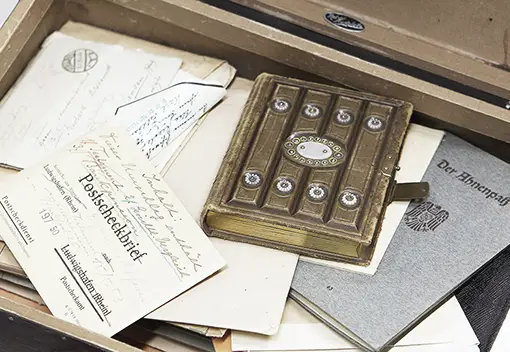
Documents on almost all questions relating to the history of JGU since 1946 can be found in the University Archives.
An overview of the archives’ holdings can be found in our holdings overview or by carrying out a search in Archivportal D. Since not all holdings are available online yet, we would be happy to advise you personally on other available archival documents. Please get in touch.
Which Digital Documents Can You Find in the Archives?
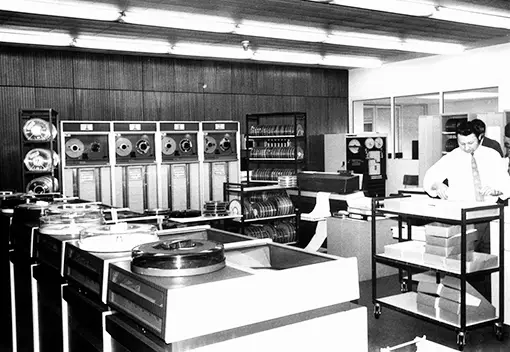
With the support of the Service Center for Digitization and Photo Documentation, the University Archives are continuously digitizing their holdings. We are happy to provide digital copies of our photos, audio documents, posters, or selected university magazines upon request.
On the Gutenberg Capture platform you can find further digital sources on the history of the Mainz University, such as the university journal JOGU.
The documents relating to the old Mainz University (1477-1798) are also almost entirely available digitally.
Gutenberg Biographics offers a first introduction to researching people.
How Can I Use the University Archives?
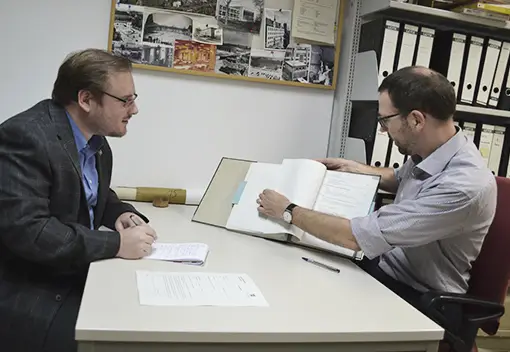
The University Archives is open to members of JGU and anyone interested. All documents that are older than 30 years can usually be used without restrictions. Special rules apply to personal documents.
We have compiled further information on using the University Archives for you.
Everything You’ve Always Wanted To Know About the History of JGU …
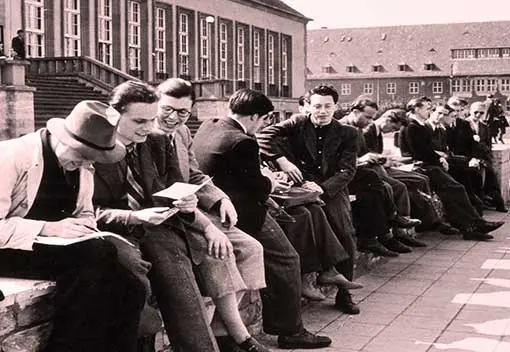
Together with the University History Research Network, the University Archives, as the University History Competence Center, is the first point of contact for all questions about the history of JGU. From digitized sources, the university's history and information on important personalities to literature references and blog posts, we have put together a variety of offers on the university's history to help you with your research or just to browse through.
From File Submission to Retention Periods
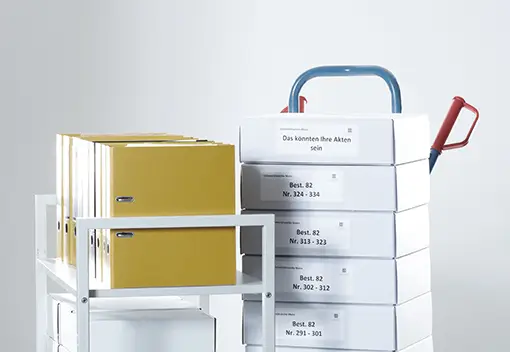
The University Archives are a service provider for all university institutions. We are happy to advise you on any questions you may have regarding document management and the handling of analog and digital documents that are no longer required.
Full Basement? We Can Help! This is how your data gets into the archives.
How to Find Us
University Archives
Central Library, Ground Floor, Room 00-233
Jakob-Welder-Weg 6
55128 Mainz

